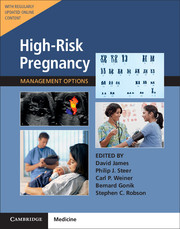Book contents
- Frontmatter
- Contents
- List of Contributors
- Preface
- Section 1 Prepregnancy Problems
- Section 2 Early Prenatal Problems
- Section 3 Late Prenatal – Fetal Problems
- 9 Prenatal Fetal Surveillance
- 10 Fetal Growth Disorders
- 11 Disorders of Amniotic Fluid
- 12 Fetal Hemolytic Disease
- 13 Fetal Thrombocytopenia
- 14 Fetal Cardiac Arrhythmias
- 15 Fetal Cardiac Abnormalities
- 16 Fetal Craniospinal and Facial Abnormalities
- 17 Fetal Genitourinary Abnormalities
- 18 Fetal Gastrointestinal and Abdominal Abnormalities
- 19 Fetal Skeletal Abnormalities
- 20 Fetal Tumors
- 21 Fetal Hydrops
- 22 Fetal Death
- Section 4 Problems Associated with Infection
- Section 5 Late Pregnancy – Maternal Problems
- Section 6 Late Prenatal – Obstetric Problems
- Section 7 Postnatal Problems
- Section 8 Normal Values
- Index
19 - Fetal Skeletal Abnormalities
from Section 3 - Late Prenatal – Fetal Problems
- Frontmatter
- Contents
- List of Contributors
- Preface
- Section 1 Prepregnancy Problems
- Section 2 Early Prenatal Problems
- Section 3 Late Prenatal – Fetal Problems
- 9 Prenatal Fetal Surveillance
- 10 Fetal Growth Disorders
- 11 Disorders of Amniotic Fluid
- 12 Fetal Hemolytic Disease
- 13 Fetal Thrombocytopenia
- 14 Fetal Cardiac Arrhythmias
- 15 Fetal Cardiac Abnormalities
- 16 Fetal Craniospinal and Facial Abnormalities
- 17 Fetal Genitourinary Abnormalities
- 18 Fetal Gastrointestinal and Abdominal Abnormalities
- 19 Fetal Skeletal Abnormalities
- 20 Fetal Tumors
- 21 Fetal Hydrops
- 22 Fetal Death
- Section 4 Problems Associated with Infection
- Section 5 Late Pregnancy – Maternal Problems
- Section 6 Late Prenatal – Obstetric Problems
- Section 7 Postnatal Problems
- Section 8 Normal Values
- Index
Summary
Introduction
The sonographic detection of a fetus with skeletal abnormalities presents the clinician with challenging diagnostic dilemmas and management options, as there are around 400 known generalized skeletal dysplasias with an estimated prevalence of 2–7 in 10,000. Some can present with significant findings early in pregnancy, but some do not have obvious findings until the mid-trimester, when they may be detected on a routine fetal anomaly scan, and others present later. However, many do not present until later in postnatal life. In some instances, the lethality of the disorder is apparent and a discussion of pregnancy termination is appropriate, but the aim prenatally is to try and arrive at a definitive diagnosis in order to offer parents accurate information regarding prognosis. As this is frequently not possible, at a minimum we should aim to distinguish lethal from nonlethal, and provide some degree of differential diagnosis so that parents can make decisions regarding further pregnancy management. An aid to the prediction of lethality is the use of a femur length/abdominal circumference (FL/AC) ratio, which, if < 0.16, distinguishes lethal from nonlethal skeletal dysplasias.
Women typically present for the prenatal diagnosis
of a skeletal abnormality in one of three ways:three ways:
• with a relevant family history,
• with an abnormality found during routine ultrasound, or
• because of a maternal condition.
Inheritable skeletal disorders may be autosomal dominant, autosomal recessive, or sex-linked, or they may arise sporadically. The genetic etiology of an increasing number of conditions is now known, making antenatal diagnosis possible early in pregnancy in families at increased risk, often before any skeletal manifestation is evident ultrasonographically. Furthermore, the advent of next-generation sequencing (NGS) and the development of NGS gene panels or whole exome sequencing can further enhance the ability to screen affected pregnancies for multiple mutations in many genes. This increases the possibility of arriving at a definitive diagnosis in a timely fashion in pregnancy, either following invasive testing and analysis of fetal amniocytes or chorionic villi or using noninvasive prenatal diagnosis and analysis of cell-free fetal DNA (cffDNA) in maternal plasma. When a skeletal dysplasia is suspected consultation with a geneticist is strongly recommended.
- Type
- Chapter
- Information
- High-Risk Pregnancy: Management OptionsFive-Year Institutional Subscription with Online Updates, pp. 472 - 500Publisher: Cambridge University PressFirst published in: 2017



